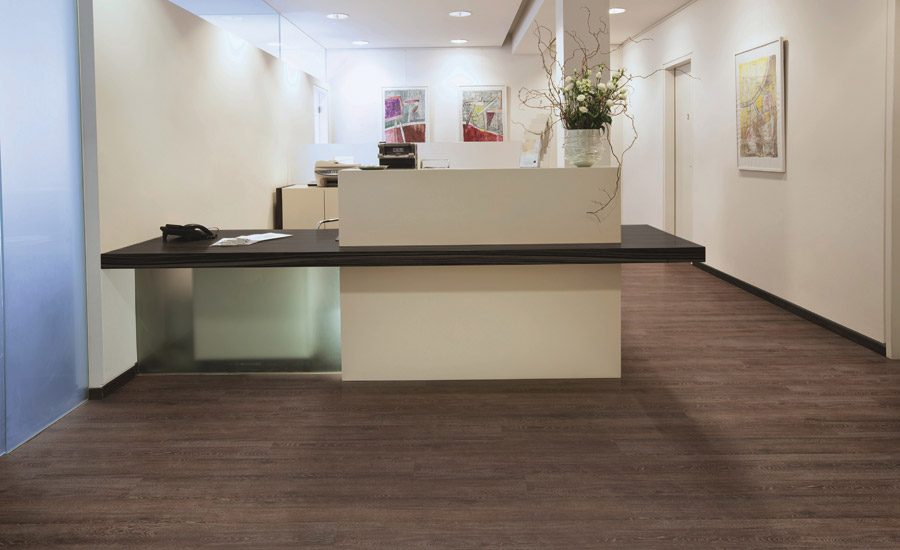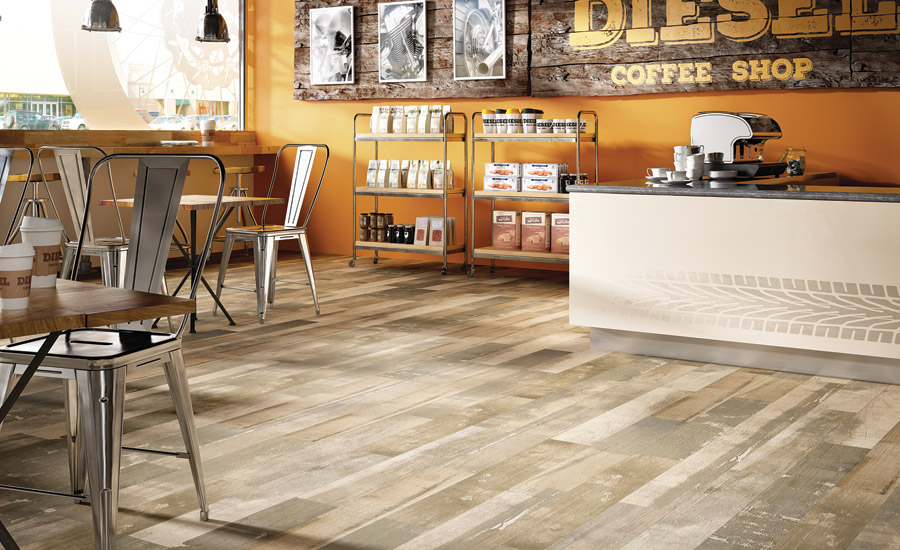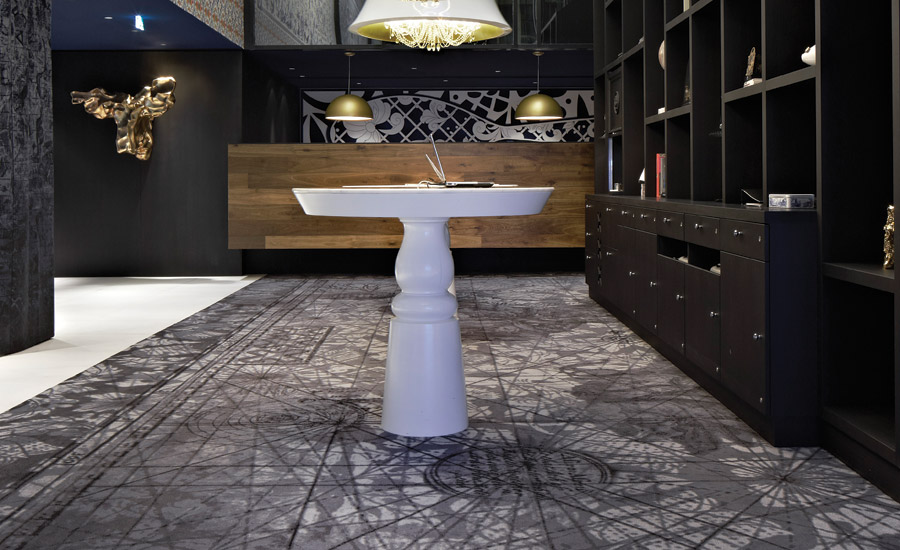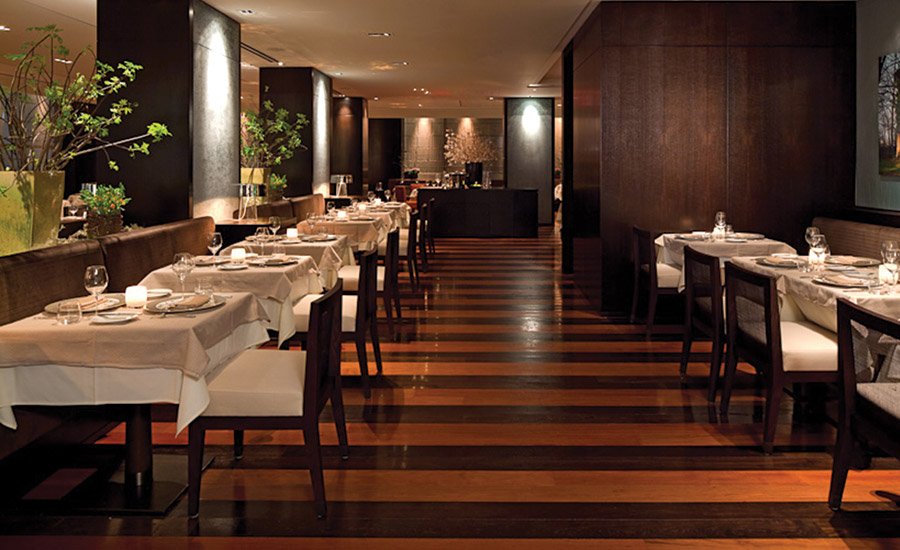What's Trending in Hospitality Flooring

Modern wood looks are a popular choice in hospitality flooring right now. Photo courtesy of Dal-Tile.

With eye-catching designs, flooring in hospitality space sets the tone for the ultimate customer experience. Photo courtesy of Durkan.

The ease of maintenance with Metroflor’s Aspecta 10 is ideal for busy hospitality settings. Photo courtesy of Metroflor.

Warm tones like grey are currently a top choice for hospitality flooring. Photo courtesy of Desso.


Large-scale designs in hospitality carpet sets the sector apart from commercial flooring. Photo courtesy of Encore Hospitality Carpet.






Evolving far beyond the hotel and lodging industry, the hospitality flooring sector has grown to include an abundance of spaces. We set out to discover what drives trends in this category, and what’s at the forefront of design. From movie theaters and hotel lobbies to convention centers and day spas, the flooring in hospitality spaces is intended to be one of the first things to welcome guests upon their arrival.
“At its core, the concept of hospitality is the idea of making people feel welcome,” said John Hall, Dal-Tile’s hospitality national account manager. “This can be extended to multiple types of establishments, including hotels, restaurants and cruise ships. Regardless of the location, hospitality is focused on customer care and service. The goal is to create a space and atmosphere that makes guests feel comfortable and at ease.
Setting the tone for the ultimate customer experience, hospitality flooring uniquely marries the performance found in commercial flooring, with the comfortable style we’ve come to expect from residential flooring, to create a visually-appealing and durable happy medium.
“The hospitality flooring segment is unique in that the demands are commercial from a performance standpoint, and in many cases, residential in appearance,” said David Baird, director of hospitality at Mannington. “Not everybody wants their hotel to look like a casino now but more like a home.”
With the help of architects and designers, manufacturers are developing products to help create memorably hospitable spaces starting from the floor up.
“Architects and designers that specialize in hospitality are now creating very unique environments,” said Karen Rosen of Junckers Hardwood. “It is a fun time to be involved with hospitality, since hotels and restaurants aim to create an environment that you would not find at work or home. In the United States, we are fortunate to be near the leading hospitality designers in the world and they push the limits to create the ‘wow’ factor.”
Driven by Design
While the order of importance is up for debate, manufacturers across the board agree that elements of design, color and performance are what drive trends in the hospitality segment. “Design is driven very much by style,” said Richard Heaver, president of Encore Hospitality Carpet. “Designers are looking to create something new and innovative in every project that they do. They like to be creative first, and they want to be on the cutting edge of design. That’s what really drives hospitality design.”
Hall added, “The most important factor is the design criteria. Designers are developing palettes based on trends, finding the right look, size and a unique design that [have] staying power.”
These days, sophistication is on trend and is the “right look” for the hospitality sector, according to Jamann Stepp of USFloors/USFContract. “Spaces are going away from bright and busy colors to quiet and sophisticated.”
In broadloom, this trend of sophistication is being achieved with warm tones and greys. “We are seeing trends towards more grey or other neutral color palettes,” said Mike Gallman, senior vice president–product, Mohawk Group. “Accent colors are still popular to add that pop of color.”
According to Robert Langstaff, director of design for Metroflor, this use color is what sets hospitality flooring apart. “The use of more design and color to create different mood sets flooring in hospitality settings apart,” he said. “For example, the use of multiple colors of one design laid out in a random manner to create a more rustic yet sophisticated look, similar to a listello tile. [Clear] design and colors that accent or pop add to the brand impression that many hospitality venues desire.”
Luxury Vinyl Tile (LVT) wood grain visuals, Euro greys, matte finishes and tone-on-tone looks in the hard surface division are also speaking to this trend of warmth and sophistication in hospitality applications. “Modern wood looks are very popular now without the traditional graining,” said Baird. “Also, neutral shades in wider plank formats.”
In addition to being aesthetically pleasing, hospitality flooring is expected to perform well under the demands of high foot traffic, varying noise levels and the need for quick installation and project turnaround.
“Design selections are being driven by a number of things but two in particular,” said Mannington’s Baird. “Owners still want beautiful spaces but they also want better performance out of their interiors.”
Keith Bensch, senior vice president of sales for Shannon Specialty Floors, added, “Performance features such as: low maintenance, no scuff, no buff and no polish in resilient floors and sound-reducing adhesives have also made their way into [a level of] importance in the hospitality segment.”
According to Baird, LVT is “red-hot” in the hospitality sector due to its performance qualities.
“With the abundance of performance and visual options with LVT flooring, the product selection can be customized to fit exactly the needs of the client,” said Lindsey Nisbet of Earthwerks. “We are seeing trends accentuating smaller scale planks, but focusing on the layout of the installation. Luxury vinyl tiles and planks are a great solution for not only high-traffic common areas, but for the private spaces as well.”
Baird added, “Owners like it because it can stay down for 18 to 20 years versus carpet that turns every five to seven. Now you can go in and replace soft surfaces only, versus having to renovate the entire room. Also, floating floors (non-adhered to the subfloor) allow for faster installations so the room is back up and generating revenue quicker. And installed over an underlayment, sound abatement [in LVT] is excellent compared to other hard surfaces.”
Maintenance Required
No matter the flooring selection, regular and proper maintenance is a critical component to keeping flooring in hospitality applications looking good and performing well.
“All flooring requires a good maintenance plan,” said Stepp. Recognizing the importance of creating flooring that not only looks great in hospitality applications but stands up to the demands of the sector, manufacturers are making it easier for end-users to maintain their flooring—from offering finishing and maintenance products to creating flooring that requires very little attention and minor spot-cleaning.
“Junckers is fortunate since not only are we a flooring manufacturer, but we are also a manufacturer of finishes and maintenance products,” said Rosen. “This allows us to incorporate colored oils or finishes into the maintenance plan. As the creator of the flooring, we really want those floors to be durable and beautiful. This requires outlining a maintenance plan for the client.”
Metroflor is taking things a step further, and simplifying the maintenance process for end-users.
”In general, all you need to do with our Metroflor product is to use a neutral cleaner and then wipe up with a microfiber mop,” said Paul Eanes, vice president of sales for Metroflor. “There is no need for harsh commercial cleaners or heavy abrasive pads. They will only take off the wear layer and scratch the print.”
For end-users who might find proper maintenance challenging, it is imperative to select a practical choice of colors and design,” stated John Reader, general manager for Desso, a Tarkett Company.
Looking for a reprint of this article?
From high-res PDFs to custom plaques, order your copy today!
















